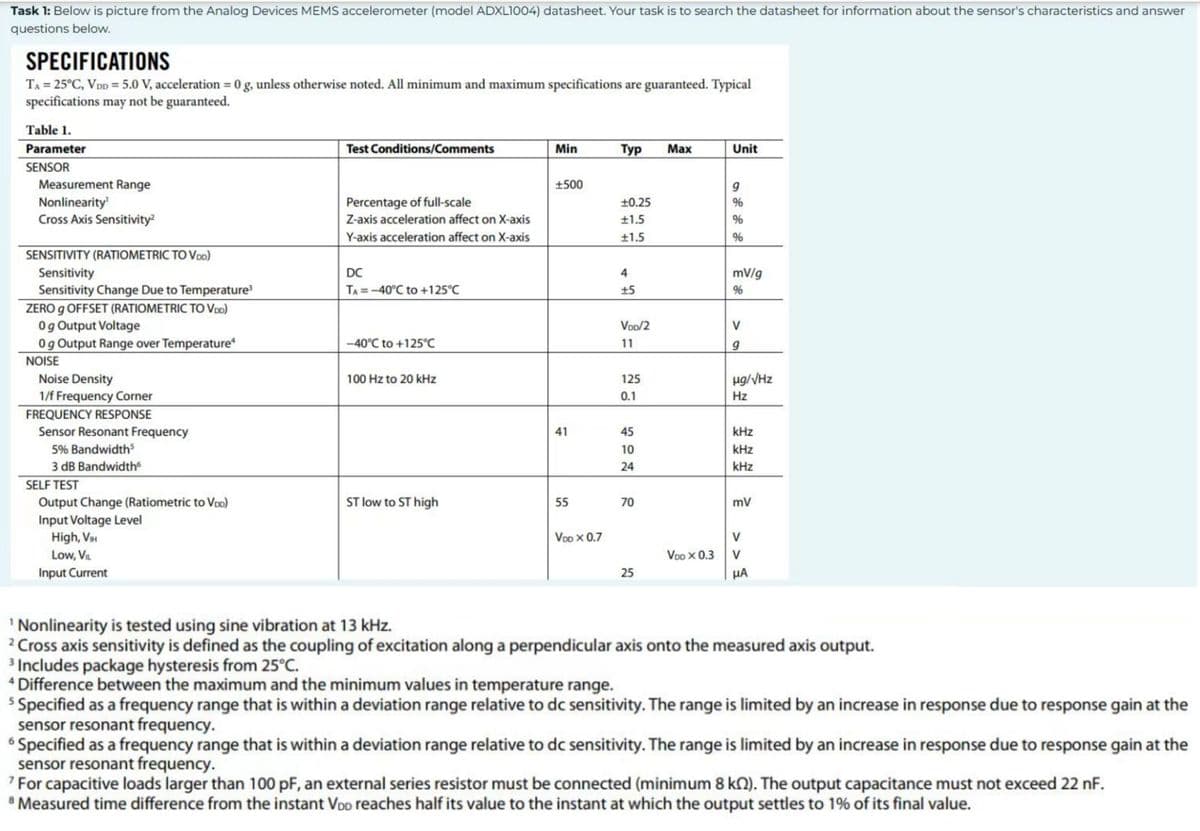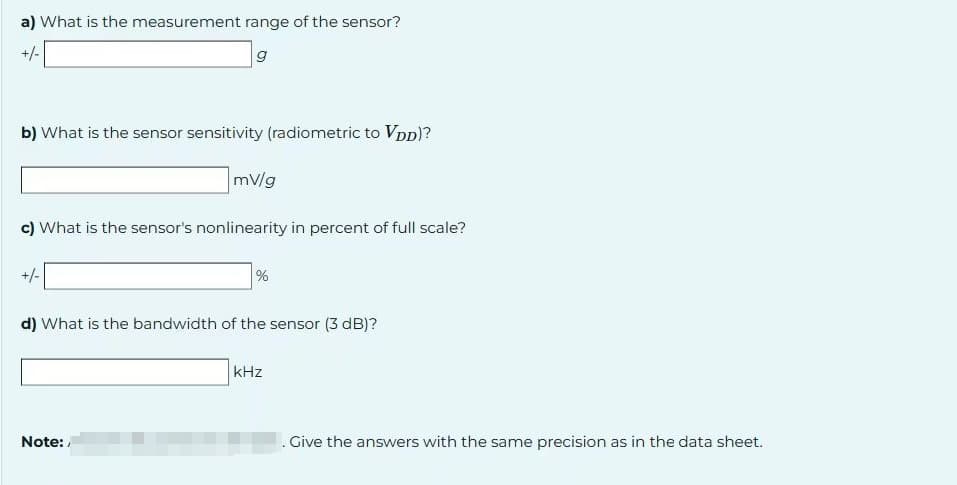a) What is the measurement range of the sensor? +/- g b) What is the sensor sensitivity (radiometric to VDD)? mV/g c) What is the sensor's nonlinearity in percent of full scale? +/- % d) What is the bandwidth of the sensor (3 dB)?
a) What is the measurement range of the sensor? +/- g b) What is the sensor sensitivity (radiometric to VDD)? mV/g c) What is the sensor's nonlinearity in percent of full scale? +/- % d) What is the bandwidth of the sensor (3 dB)?
Electricity for Refrigeration, Heating, and Air Conditioning (MindTap Course List)
10th Edition
ISBN:9781337399128
Author:Russell E. Smith
Publisher:Russell E. Smith
Chapter17: Commercial And Industrial Air-conditioning Control Systems
Section: Chapter Questions
Problem 13RQ
Related questions
Question
100%

Transcribed Image Text:Task 1: Below is picture from the Analog Devices MEMS accelerometer (model ADXL1004) datasheet. Your task is to search the datasheet for information about the sensor's characteristics and answer
questions below.
SPECIFICATIONS
TA = 25°C, VDD = 5.0 V, acceleration = 0 g, unless otherwise noted. All minimum and maximum specifications are guaranteed. Typical
specifications may not be guaranteed.
Table 1.
Parameter
SENSOR
6
Measurement Range
Nonlinearity
Cross Axis Sensitivity²
SENSITIVITY (RATIOMETRIC TO VDD)
Sensitivity
Sensitivity Change Due to Temperature³
ZERO g OFFSET (RATIOMETRIC TO VDD)
Og Output Voltage
Og Output Range over Temperature
NOISE
Noise Density
1/f Frequency Corner
FREQUENCY RESPONSE
Sensor Resonant Frequency
5% Bandwidth"
3 dB Bandwidth
SELF TEST
Output Change (Ratiometric to VDD)
Input Voltage Level
High, VIH
Low, VIL
Input Current
Test Conditions/Comments
Percentage of full-scale
Z-axis acceleration affect on X-axis
Y-axis acceleration affect on X-axis
DC
TA= -40°C to +125°C
-40°C to +125°C
100 Hz to 20 kHz
ST low to ST high
Min
+500
41
55
VDD X 0.7
Typ
+0.25
+1.5
+1.5
4
+5
VOD/2
11
125
0.1
45
10
24
70
25
Max
VDD X 0.3
Unit
9
%
%
%
mV/g
%
V
9
µg/√Hz
Hz
؟
<<
*
*
*
kHz
kHz
kHz
mV
'Nonlinearity is tested using sine vibration at 13 kHz.
2 Cross axis sensitivity is defined as the coupling of excitation along a perpendicular axis onto the measured axis output.
3 Includes package hysteresis from 25°C.
4 Difference between the maximum and the minimum values in temperature range.
5 Specified as a frequency range that is within a deviation range relative to dc sensitivity. The range is limited by an increase in response due to response gain at the
sensor resonant frequency.
Specified as a frequency range that is within a deviation range relative to dc sensitivity. The range is limited by an increase in response due to response gain at the
sensor resonant frequency.
7 For capacitive loads larger than 100 pF, an external series resistor must be connected (minimum 8 k). The output capacitance must not exceed 22 nF.
8 Measured time difference from the instant VDD reaches half its value to the instant at which the output settles to 1% of its final value.

Transcribed Image Text:a) What is the measurement range of the sensor?
+/-
g
b) What is the sensor sensitivity (radiometric to Vpp)?
c) What is the sensor's nonlinearity in percent of full scale?
+/-
mV/g
Note:
%
d) What is the bandwidth of the sensor (3 dB)?
kHz
. Give the answers with the same precision as in the data sheet.
Expert Solution
This question has been solved!
Explore an expertly crafted, step-by-step solution for a thorough understanding of key concepts.
Step by step
Solved in 4 steps with 4 images

Knowledge Booster
Learn more about
Need a deep-dive on the concept behind this application? Look no further. Learn more about this topic, electrical-engineering and related others by exploring similar questions and additional content below.Recommended textbooks for you

Electricity for Refrigeration, Heating, and Air C…
Mechanical Engineering
ISBN:
9781337399128
Author:
Russell E. Smith
Publisher:
Cengage Learning

Electricity for Refrigeration, Heating, and Air C…
Mechanical Engineering
ISBN:
9781337399128
Author:
Russell E. Smith
Publisher:
Cengage Learning